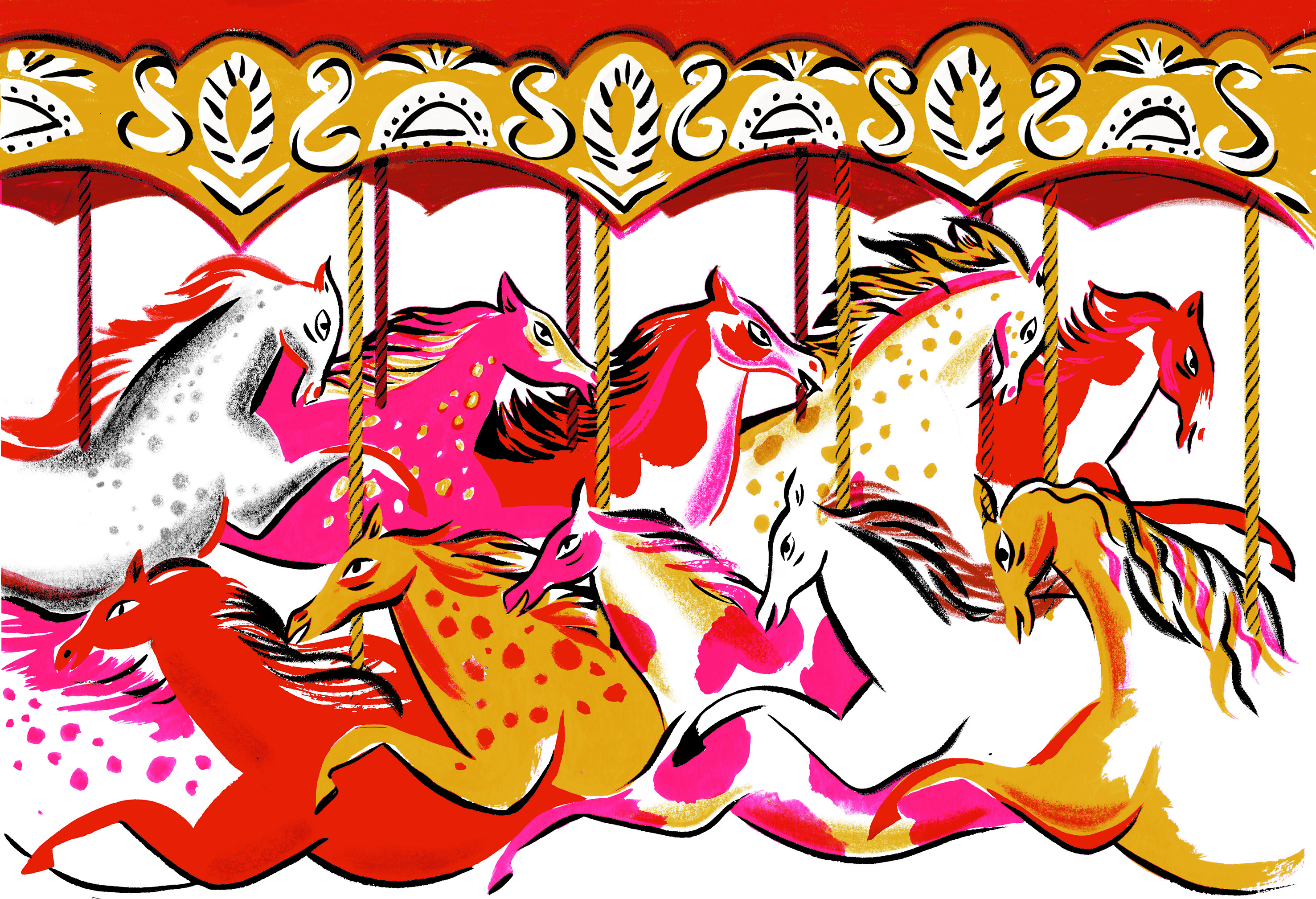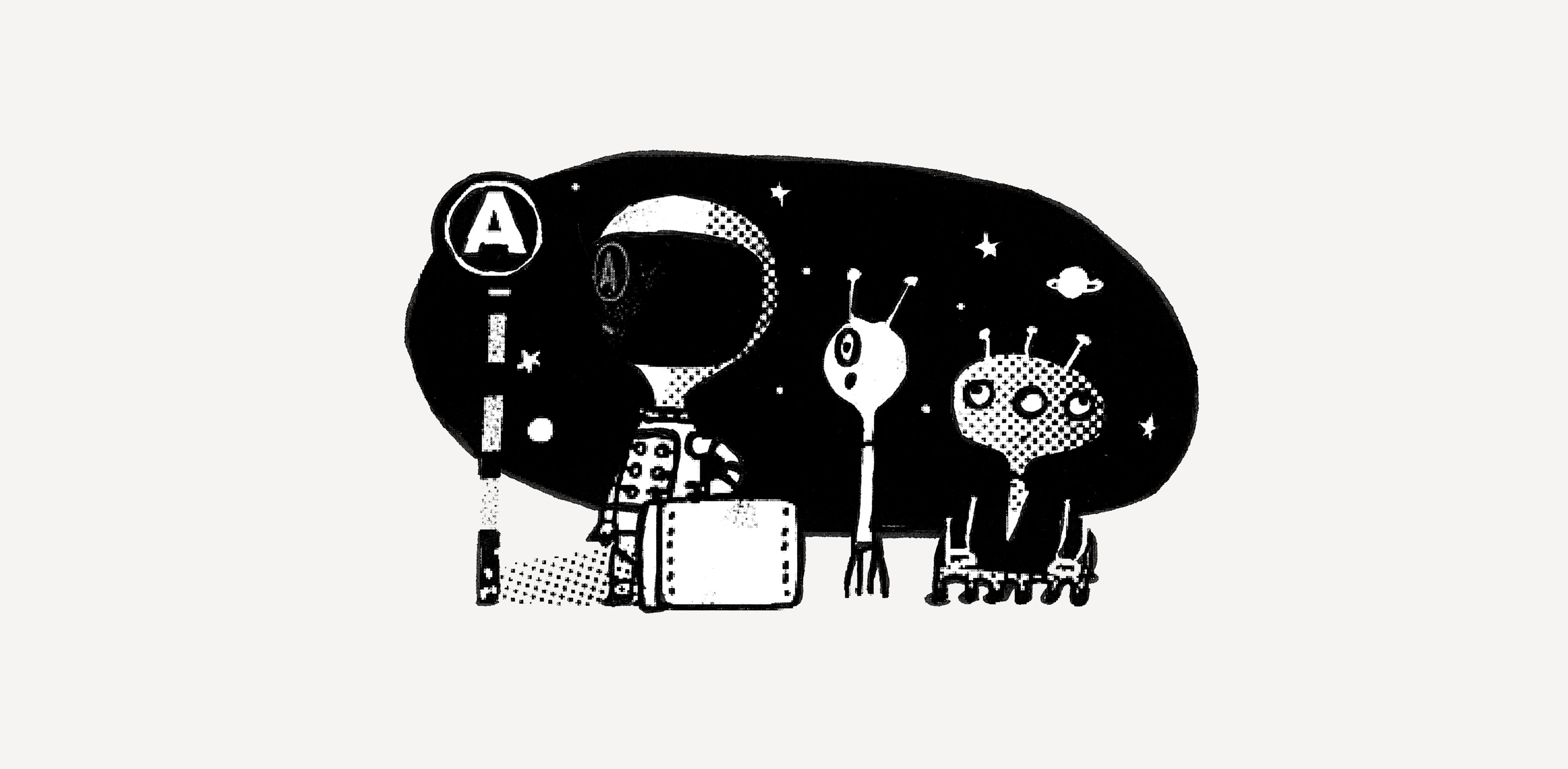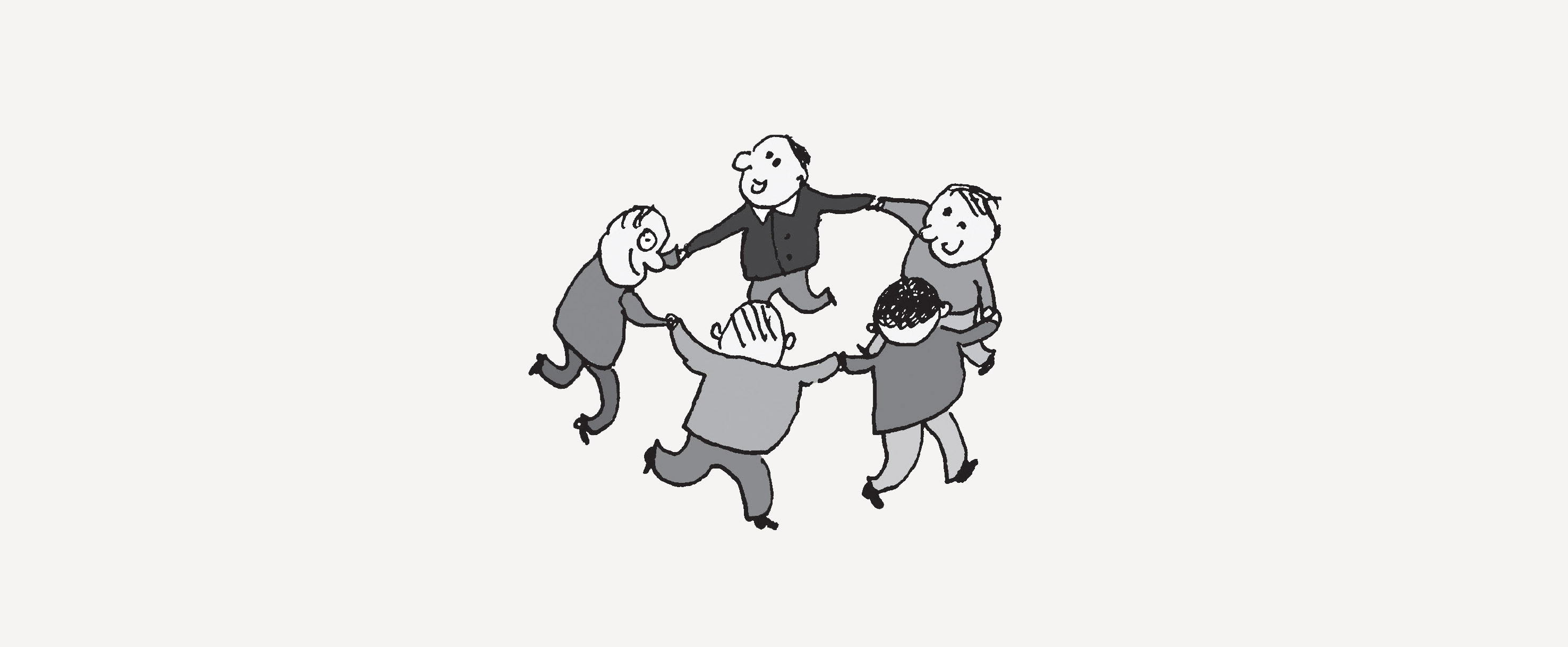
We owe the Ferris wheel and the carousel to the Ottoman Turks, and the roller coaster to Tsar Peter the Great and Tsarina Catherine the Great. The roller coaster is good for pious Christians; it also helps with kidney stones.
Karuzela, karuzela, na Bielanach co niedziela (“Carousel, carousel, every Sunday in Bielany”) Maria Koterbska sang in 1955. This song, popularized by the socialist realist comedy Irena do domu!, is known in Poland even by those who don’t remember the Polish People’s Republic, don’t know anything about Koterbska, and have never in their lives set foot in Warsaw’s Bielany district. That’s the power of simplicity in rhythm and melody, but also of whirling fun; of the vision of a literal flight of Sunday fancy. And when we think ‘carousel’, we no longer imagine just a ride on horses rotating on a wheel or hanging on chains. This symbol of the amusement park is also full of other mechanical wonders, such as roller coasters and Ferris wheels. Whether you have a taste for big coasters, or whether slow-moving swans suffice, you should take a victory lap on your favourite ride in May – to mark a great anniversary of the carousel. But we’ll come back to that, on a later go-round.
Knightly play
The Warsaw University Library’s collection includes a beautiful drawing by 16th-century Flemish painter Frans Floris showing a prototype of carousel fun. Specifically, the illustration shows the wedding of Alexander Farnese, Duke of Parma, to Infanta Maria of Portugal in 1565 on the Grand Place in Brussels. According to tradition, the ceremony was marked by an amusement with the Italian name garosello. It was a sort of training for knights, charging in a circle on horses and knocking down balls or rings hung on poles. Apparently, Western knights had spotted this technique among the warriors of Byzantium and the Near East.
Then, in the 16th century, knights passed definitively into history. Once they ran out of knights, the European burghers tried to continue the traditional, effective game in their own way – just with less pomp, and no military discipline. Testimony to how much the game entered into the townspeople’s blood is seen in the Parisian name Place du Carrousel, where similar amusements were set up in the French capital.
Meanwhile, also on the former territory of Byzantium where the Turks settled, people had fun in a circle, too. Also without soldiers, and even without horses. In May 1620 – so precisely 400 years ago – the British traveller to Ottoman Turkey Peter Mundy saw three of the machines that are typical of today’s fun fairs. The first was a type of extreme swing (only for adults!), the second a Ferris wheel (for children), and the third a carousel (also for children). Mundy saw them and delightedly described them for the Western world in a collection published under the title The Travels of Peter Mundy in Europe and Asia, 1608–1667.
Mundy’s tale indicates that he spotted these fantastic mechanical amusement devices during the Muslim Eid al-Adha holiday in the city known for years as Philippopolis – today’s Plovdiv, Bulgaria. The crazy ideas later made it to the West. Whirling mechanical carousels replaced the riders chasing each other around the plazas. The steeds were to return later, but only as wooden horses, driven around in circles first by a steam engine, later by electricity.
Flight to the moon
It’s interesting to see whether they’ll remember this happy anniversary in Plovdiv, or whether this opportunity for promoting Bulgaria as the cradle of amusement in Europe will be squandered. To be fair though, we must admit that among the machines of Plovdiv, the carousel seemed the most original. Various kinds of swing were known earlier (even in ancient Greece), and the Ferris wheel was certainly already functioning in Constantinople. But Plovdiv can boast several of the machines operating simultaneously – for good measure, this allows us to acknowledge it as the first city with an amusement park! Admittedly, already in the Middle Ages, fairs and indulgences were a place of fun and jugglers’ shows. But it’s one thing to marvel at a juggler, and another to take a wild ride on the whirling saddles, with the wind in your hair.
So why is the Polish word for amusement park not Philippopolis or Plovdivek, but lunapark? Where does the name come from? The puzzle isn’t made any easier by the way some unfortunates confuse the terms lunapark and lupanar. An embarrassing mistake: a lupanar is in fact an Ancient Roman brothel, and literally a ‘wolf’s den’ (the word lupa, ‘she-wolf’, was a popular term for ‘prostitute’). Of course, it does happen that clients look for women of easy virtue in amusement parks, but this is not where our path lies. The key concept isn’t she-wolves, but the moon (luna). Because Lunapark, or actually Luna Park, is the name of the amusement park that started operating on the New York peninsula Coney Island in 1903. The name referred to the park’s main attraction: the airship Luna, which looked like something from a Jules Verne fantasy, and which took 30 passengers at a time on a sort of improvised journey to the moon. The wild ride simulated first a departure from America, and then from the surface of the Earth, then a landing on the Silver Sphere to meet with the Selenites.
Of course, this was just one of many attractions. Visitors could slide down from various objects and crash in various ways; take a trip on a submarine to the North Pole; and then take in exotic dancers and trained animals. The illuminations made a great impression: towers of lights, stars and half-moons, colourful inscriptions. “With the charm of hundreds of thousands of multicoloured electric lights, New York’s Luna Park, the main amusement spot for this anthill of people who during the day chase unflaggingly after business and making money, shines late into the night,” is how the popular Polish newspaper Ilustrowany Kurier Codzienny captioned a picture of Coney Island in a photographic supplement on 23rd September 1935.
Luna Park was a huge success. Copies began to pop up like mushrooms after a rainstorm: in Germany, France, Japan and even Egypt. And yet, though the name caught on, the original Luna Park went under. Crises, fires and competition took their toll. In 1979 the situation was so bad that the Coney Island Ferris wheel was at its most exciting in the final scene of the cult action film The Warriors, about New York youth gangs settling scores. And although 10 years ago the park was reactivated with new investment, it can’t compare with theme-based parks like Disneyland.
Entertainment gardens
In Europe, regardless of the term ‘lunapark’ used in many languages, the symbol of amusement parks is Copenhagen’s Tivoli. In fact, its fame has radiated all over the world. Suffice it to say that Walt Disney was so delighted by his visit to Tivoli that he wanted to recreate the atmosphere in his Disneyland.
Where did this admiration come from? Tivoli was opened in 1843, 60 years before Coney Island’s Luna Park and 112 before the first Disneyland in California. It took its name from ancient times – quite strangely, because, in fact, the Romans preferred lupanars and gladiator arenas, but the period of the emperor Hadrian left behind it, near Rome, a wonderful estate of gardens, theatres, fountains and baths in the small town of Tibur, later renamed Tivoli. Over the years, it drew the Roman elites. And just as ancient Tivoli became a place of relaxation for the emperor and wealthy Romans, the one in Copenhagen was meant to provide recreation for Danes and visitors from abroad, bored with everyday life in the industrial age.
Besides gardens and a theatre, it drew them in with something Hadrian didn’t have: fireworks and carousels. And starting in 1914, a wooden roller coaster, too. It’s still operating – one of the oldest in the world.
Pious coasters
Today roller coasters are the symbol of a proper amusement park. But the prototypes were strange. They’re Russian wooden slides, covered with ice and snow, for riding on sleds and blocks of ice with seats, similar to today’s bobsled tracks. They appeared in Russia in the 17th century, and in Saint Petersburg were overseen by Peter the Great himself. Decades later, they were also promoted by Catherine the Great, who apparently also developed the summer version of this entertainment. The fun lasted longer, though now it definitely didn’t involve sleds or snow, but carts on tracks. Still, it was only the Americans who turned it into real fun. The tracks got longer and longer and looped around; the cars went faster and faster; the riders screamed louder and louder. Interestingly, at the end of the 19th century, this amusement was promoted among New Yorkers as a Christian alternative to ‘Satanic’ temptations such as bars and public houses.
Today, roller coasters attract everybody who’s looking for a thrill of emotions without jumping off or out of something while attached to a parachute or a bungee cord. Everyone who’s hungry for endorphins, dopamine and adrenaline; anyone who needs some euphoria. A few years ago, there was an attempt to persuade the less enthusiastic using scientific research. It indicated that fast rides helped get rid of kidney stones. Professor David Wartinger of Michigan State University personally rode roller coasters equipped with silicon replicas of the urinary system and researched how copies of kidney stones responded to the g-forces. He stated that the rides sped up and eased their exit from the body, which in normal conditions is very painful. The mad scientist’s work was honoured in 2018 with an Ig Noble – a prize for a discovery that’s as funny and absurd as it is thought-provoking.
Brought to you by Pan Twardowski
The carousel in Bielany during the days of post-war leader Bolesław Bierut certainly wasn’t the first in Poland. Nor was it the only recreational opportunity in Bielany Woods, where people went for recreation as early as the 19th century. In fact, people were swinging and doing flips in various parks in all the large cities, not just in Warsaw. And the capital wasn’t even the site of Poland’s first real amusement park.
That was set up in Poznań in 1929 for the General National Exhibition. The photos that survive are impressive. They show a huge roller coaster more than two kilometres long. And also a carousel with people whirling around in airplane-shaped cars. There was also a waterslide (so visitors could, as the press acclaimed, “slide down from a high elevation in a flash, riding a boat into the open water of a pond”) and an autodrome (with miniature cars for both children and adults). The entrance to the park was decorated with a sculpture of Pan Twardowski, a Polish folk hero who made a deal with the Devil, sitting on the moon – an obvious reference to the famous Luna Park. But the official name of this shrine was ‘The Pan Twardowski Amusement Park’ – and apparently it was the 1929 fair that introduced wesołe miasteczko (literally, ‘happy little town’) into the Polish language as the term for amusement park.
The Poznań exhibition also had a certain dark side, quite typical for that era. One of the attractions was a ‘negroes’ village’, full of exotically dressed (or undressed) Africans, with whom visitors to the exhibition could pose for photos. Similar ‘human zoos’ could be seen in many European cities during large international exhibitions at the turn of the 19th and 20th centuries. Nobody batted an eye; Euro-centrism and colonialism were both in fine fettle back then. After all, in the circuses of Europe and America at the time, human ‘freaks’ were also exploited: conjoined twins, sufferers from dwarfism and gigantism, people with rare and often macabre deformities.
The carousel of history has flung these ‘attractions’ off from the programme of contemporary amusement parks. Today, we have fun only at our own expense – possibly that of our loved ones, who faint with terror and shriek loudly on roller coasters. That’s good, because after all, American preachers believe they frighten off sinful temptations, and American scientists say they get rid of kidney stones.
Translated from the Polish by Nathaniel Espino










